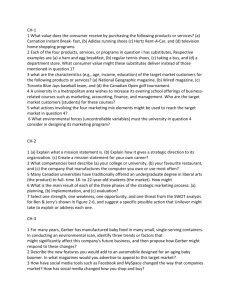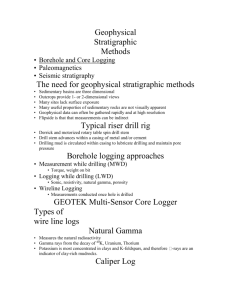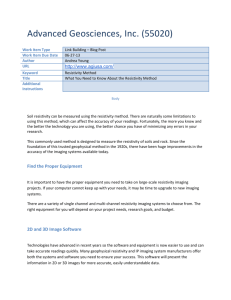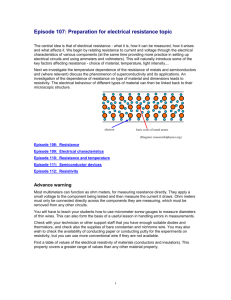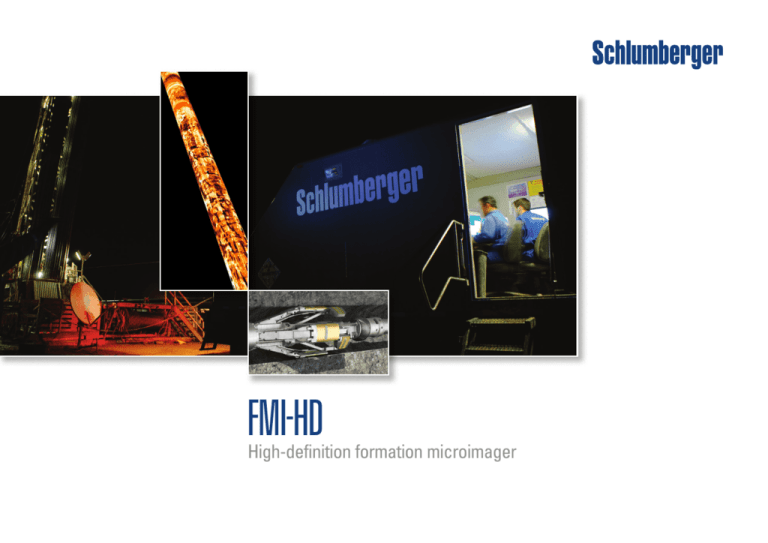
FMI-HD
High-definition formation microimager
FMI-HD
Applications
■■
Structural analysis and modeling
– 3D near-wellbore and interwell structural modeling
– Structural cross sections
– Detection and determination of faults, folds, and unconformities
– True, accurate structural dip in almost any formation
■■
Naturally fractured reservoir characterization and modeling
– Discrete fracture network (DFN) modeling
– Direct visual quantification of fracture orientation and density
– Quantification of fracture aperture and fracture porosity
■■
Secondary porosity evaluation in carbonate and igneous reservoirs
– Quantification of matrix and vuggy fractions of porosity
– Partitioning of isolated, connected, and fracture-connected vuggy porosity
– Direct visual identification of macroporosity and nonporous nodules
– Estimation of permeability and variable cementation exponent m
■■
Thin-bed detection and evaluation
– Layer delineation for high-resolution deterministic petrophysical
evaluation
– Fast quantification of interval net-to-gross ratio and net pay
– Direct visualization of beds down to millimeter scale
01
■■
Reservoir characterization workflow
– Direct visual or automatic textural classification of facies and rock types
– Realistic population of reservoir bodies with petrophysical parameters
– Recognition of anisotropy, permeability barriers, and permeability paths
■■
Sedimentology and sequence stratigraphy
– Deterministic or stochastic modeling of reservoir bodies
– Definition and characterization of sedimentary bodies and their boundaries
– Qualitative vertical profiles of grain size and stacking pattern
– Paleocurrent directions
■■
Geomechanics
– Determination of principal stress directions
– Calibration of mechanical earth model (MEM)
– Mud weight selection
■■
Complement to coring and formation tester programs
– Depth matching and orientation for whole cores
– Reservoir description for intervals not cored
– Information about the reservoir before core analysis is available
– Depth matching for sidewall core samples and wireline
formation testers
Benefits
Features
■■
■■
■■
■■
■■
■■
■■
High-quality images in borehole environments that could not be
clearly imaged previously, such as salt-saturated water-base mud (WBM)
Clear images of fractures and vugs in high-resistivity formations
such as carbonates or basement
One-trip seamless imaging of both high- and low-resistivity
formations
Acquisition of formation images in some wells drilled with oil-
base mud (OBM) that are comparable in quality to conventional
imaging in WBM
■■
New electronics and novel signal processing
Automatic handling of signal phase for improved quality in extreme
saline environments
■■
Noise reduction from enhanced parallel processing
■■
16-bit digitization electronics, improved over conventional 10 bit
■■
Borehole coverage of 80% in 8-in hole
■■
High spatial resolution (nominal 0.2 in)
■■
Pad tilting for application in deviated and horizontal wells
■■
Top-combinable with most wireline services
Faster, simplified operation with reduced human dependency
Greater service reliability from new electronics and rigorous
qualification process
The FMI-HD high-definition formation microimager can be deployed to total depth in
highly deviated or horizontal wells where gravity descent is not possible by using the
UltraTRAC* all-terrain well tractor.
02
Environments that cannot be
clearly imaged with conventional
microresistivity imaging technology,
such as wells drilled with saltsaturated muds or high-resistivity
reservoirs, can now be seen in high
fidelity and detail-revealing clarity
with the FMI-HD* high-definition
formation microimager. All-new
electronics and parallel signal
processing enable imaging even
in wells drilled with OBM if the
formation resistivity is sufficiently
high and the oil/water ratio is low.
Nonconductive mud
AC current path
Upper electrode
Mass-insulated sub
Lower electrodes
The FMI-HD high-definition formation microimager creates a microresistivity
image of the borehole wall from measurement of high- and low-resolution
components of the current flowing through the formation.
03
The FMI-HD high-definition formation microimager employs the well-proven microresistivity
imaging approach of the industry-standard FMI*
fullbore formation microimager. Measurement
begins with an applied voltage that causes an
alternating current to flow from the array of 192
pad-mounted “button” electrodes through the
formation to the upper cartridge housing, which
acts as a return electrode.
The microresistivity image of the borehole
wall is created from the current measured by
the array of buttons. Microresistivity changes
related to lithologic and petrophysical variations
in the rock, which are conveyed mainly by
the high-resolution current component, are
interpreted on the image in terms of rock
texture, stratigraphic and structural features
including dip, and fractures.
As the current emerges from a button on the pad
or its hinged flap extensions, its path is initially
focused on the small volume of the formation
directly facing the button. The current path
expands rapidly across the formation between
the lower and upper electrodes. The current
consists of two components:
The spatial resolution of the FMI-HD tool is
defined by the button size at 0.2 in. An object
larger than 0.2 in appears at approximately its
true size. An object much smaller than 0.2 in
may also be visible in the image if the object
has a resistivity contrast with the surrounding
formation, however small, and the imaging tool
is sensitive enough to measure the resulting
small change in the average formation resistivity
within the 0.2-in measurement.
■■
■■
high-resolution component, modulated by the
resistivity variations in the formation directly
facing the button
low-resolution component, modulated by the
resistivity of the formation between the lower
and upper electrodes.
04
Defining high-definition
“High definition” denotes a superior sensitivity
to fine contrasts in formation resistivity,
ensuring that the smallest geological subtleties
are accurately imaged. Although most of the
currently available imaging tools for wells
drilled with conductive WBM specify a spatial
resolution of 0.2 in vertically and azimuthally,
this specification does not guarantee that
all of the imagers perform equally well. The
differentiator is their sensitivity to fine contrasts.
The FMI-HD microimager takes high-definition
to a new level. It builds on the field-proven
design of the FMI fullbore formation
microimager sonde by incorporating completely
new electronics to provide a step-improvement
in operating range, reliability, and image quality.
New features such as enhanced parallel signal
processing and high-resolution analog-todigital conversion have significantly improved
the tool signal-to-noise ratio to increase image
definition by a factor of four.
The FMI-HD microimager delivers high definition by adding
completely new electronics to the industry-standard
approach established by the FMI microimager’s padmounted button electrodes.
05
The visibility and interpretability of small
features on images from the FMI-HD tool is
increased for all conditions, even for features
that are much smaller than the 0.2-in nominal
resolution defined by the button size. For
example, the high-definition electronics are
sensitive enough that fluid-filled fractures less
than 10 um in width are frequently imaged.
Modern interpretation techniques estimate the size of such small features by quantifying
the current flow to the button.
Dip events are easily picked, categorized, and displayed by using the Techlog* wellbore software platform with data from the FMI-HD microimager.
06
Case Studies
Middle East: Imaging a tight sandstone gas reservoir
in a high-salinity, high-resistivity-contrast well
A Middle East operator drilled a well with highly
saline (240,000-ppm) WBM, targeting gas in
tight sandstone reservoirs. The downhole mud
resistivity of 0.02 ohm.m in comparison with
the formation resistivity of 80 to 100 ohm.m
resulted in an Rt /Rm ratio exceeding 4,000:1.
This high contrast posed a challenging logging
environment for conventional microimaging,
demanding diligent real-time analysis of image
quality and repeated log passes with carefully
optimized parameters.
Both a conventional microimager and the
FMI-HD high-definition microimager were run
to acquire high-resolution images in the well.
The FMI-HD microimager uses automatic
signal processing optimization, which
eliminates manually setting the tool parameters
and makes it possible to acquire clear,
representative images of formation geology in Rt /Rm contrasts as high as 200,000:1.
07
The images from the FMI-HD tool delivered
a significant improvement in image quality
across the target zone. Natural fractures,
drilling-induced fractures indicating the
maximum horizontal stress direction, and
sedimentary structures such as rippled
laminations are all readily interpreted from
the high-definition images. They are difficult
to interpret from standard images because
the conventional tool is not easily tuned to
the formation in this environment of extreme
resistivity contrast.
Comparison of images from a conventional imager (left) and the FMI-HD high-definition microimager (right) shows the step-change improvement in image quality in
extreme resistivity conditions.
08
Case Study
Permian basin: Imaging a high-resistivity carbonate interval to identify secondary porosity and natural fractures
Key evaluation objectives for an extended
interval of high-resistivity carbonates in
a Permian basin exploration well were to
identify and characterize potential zones of
secondary (vuggy) porosity and the presence
of natural fractures. However, at high
resistivities, the low signal of conventional
imaging tools amplifies the noise and results
in blurry images with ambiguous features. To
this end, both standard microresistivity images
from a conventional imaging tool and highdefinition images from the FMI-HD tool were
acquired and compared.
Both the conventional and the FMI-HD imager
tools rendered clear and representative
images of the formation geology where the
resistivity was less than 500 ohm.m. Although
the imager performance is similar, finer detail
can be seen in FMI-HD images.
09
Where the formation resistivity was highly variable, only the FMI-HD image optimally captured both high- and low-resistivity formation
images in a single pass. Automatic signal processing optimization adjusted the FMI-HD
tool to image the entire dynamic range of
formation resistivity, whereas the conventional
tool had to be reset by the engineer to optimize
either high- or low-resistivity formations and then the well relogged.
At formation resistivities exceeding 500 ohm.m,
the high-definition image provided by the FMI-HD
tool consistently provides a superior basis for
interpretation. The sharp rendering of fractures
and vugs—critical for production—makes them
readily identifiable.
Yellow
Yellow
0
G amma R ay
0
gAPI 100 0
C aliper 2
6
in
16
N
C aliper 1
6
in
16 0
255.00
0
Standard Dynamic Image
255.00
F MI-HD Dynamic Image
2.6e+02
0
2.6e+02
Image O rientation,°
E
90
S
180
W
270
Image O rientation,°
N
360
Deph, ft
X,X20
N
0
E
90
S
180
W
270
HRLA Resistivity 5
2
ohm.m 2,000
N HRLA Resistivity 4
360 2
ohm.m 2,000
A conventional dynamic image (left of depth track) from the Permian basin well
is compared with a high-definition image from the FMI-HD microimager (right
of depth track) and resistivity curves from an HRLA* high-resolution laterolog
array (far right). The superior definition of the images from the FMI-HD tool in the
800-ohm.m brecciated carbonate below X,X25 ft clearly delineates more than 30
fracture traces, of which only a few can be seen in the standard image. Bedding
planes are also readily identifiable in the images from the FMI-HD tool, but not
in the standard image. Even more remarkable is the difference between the two
images in the shale above X,X25 ft; the conventional tool was configured for
imaging in a high-resistivity formation, which causes it to completely misread the shale whereas the FMI-HD tool renders all of the details.
X,X22.5
X,X25
X,X27.5
X,X30
The images at 0.2-in vertical resolution from the FMI-HD microimager can be
displayed on a virtual 3D core by the Techlog wellbore software platform at any
scale down to 1:1. Patches of well-developed vuggy porosity are clearly visible
as dark spots in this example.
10
Case Study
Southern Mexico: Imaging a well drilled with OBM
for open fractures in carbonate reservoirs
Jurassic and Cretaceous carbonates in
the South region of Mexico are commonly
tight but can be productive where porosity
and permeability are locally enhanced by
the presence of natural fractures or the
formation of vuggy porosity as a product
of diagenesis. To assess the possibility of
completing the 8½-in section of a well, the
operator wanted high-resolution formation
images of the potential reservoirs. However,
the well had been drilled with OBM to
mitigate potential hazards and conventional
imaging tools are designed to operate in a
conductive environment.
The increased signal-to-noise ratio, highresolution analog-to-digital conversion, and
novel signal processing technique of the
FMI-HD tool enabled successfully acquiring
high-definition images in the nonconductive
well environment to characterize the
fractures and identify potentially productive
11
intervals. The quality of the images acquired
is practically indistinguishable from images
that would have been acquired in WBM.
Bedding and fine laminations, fractures,
and minor faults were identified. In addition,
a core-like description and lithofacies
classification were performed based on the image texture.
In wells drilled with OBM, fractures
typically appear as high-resistivity (bright)
features in microresistivity images. Without
complementary data, an open fracture filled
with resistive mud filtrate is essentially
indistinguishable from a fracture that has
been cemented by resistive minerals such
as calcite or quartz. The losses that had
occurred while drilling the interval were
used to infer that the fractures are open.
Other common sources of complementary
information include acoustic images or
advanced acoustic logs.
The interpretation of images from the FMI-HD high-definition
microimager in the interval shown determined that fracture density
was too low, which would make the reservoir zone unlikely to be
productive. The operator then drilled a 6-in section with WBM,
acquired another set of high-definition images with the FMI-HD
microimager to determine fracture density, and successfully
completed the well. Logging with the FMI-HD high-definition
formation microimager is now a standard component of the
operator’s formation evaluation program, with over 50 runs to date in the region.
Numerous geologic features are clearly visualized in the images obtained with the
FMI-HD high-definition microimager from the well in the South region of Mexico
and are readily traced and classified using the Techlog wellbore software platform
on the static image to the left of the depth track. The dip magnitude and azimuth
of each feature are determined to within 2° accuracy and displayed in the farright track. From the bottom up, a formation featuring highly resistive laminations
is cut by a significant fault (pink) at X,046 ft. Above the fault is a conglomerate
containing resistive (light-colored) cobbles up to 8 in in size, which is interpreted
as a series of debris flows. A cemented bed at X,040 ft tops the conglomerate and
is clearly irregular; the top of this bed has been cut by a microfault (pink). Above
it are many fine natural shear fractures that are interpreted as open fractures on
the basis of the mud losses that occurred while drilling this depth.
12
Data from the FMI-HD high-definition formation
microimager is transmitted from the wellsite to
the operator’s office in real time.
13
FMI-HD
Specifications
Measurement
Output
Logging speed
Range of measurement
Vertical resolution
Accuracy
Depth of investigation
Mud type or weight limitations
Combinability
Special applications
Mechanical
Temperature rating
Pressure rating
Borehole size—min.
Borehole size—max.
Outside diameter
Length
Weight
Tension
Compression
† For
Formation images and dip
Image mode: 1,800 ft/h [549 m/h]
Dipmeter mode: 3,600 ft/h [1,097 m/h]
Sampling rate: 0.1 in [0.25 cm]
Borehole coverage: 80% in 8-in [20.32-cm] borehole
Horizontal resolution: 0.2 in [0.51 cm]
Vertical resolution: 0.2 in [0.51 cm]
Caliper: ±0.2 in [±0.51 cm]
Deviation: ±0.2°
Azimuth: ±2°
High-frequency component (image details): 0.39 in [1 cm]
Low-frequency component (for calibration to resistivity logs): 30 in [76.2 cm]
Water-base mud (maximum mud resistivity = 50 ohm.m)
Oil-base mud under specific conditions†
Bottom-only tool, combinable with most tools
Horizontal wells
350 degF [177 degC]
20,000 psi [138 MPa]
61⁄4 in [15.87 cm]
57⁄8 in [14.92 cm] in good hole conditions using a kit
21 in [53.34 cm]
5 in [12.70 cm]
25.43 [7.75 m]
443 lbm [201 kg]
12,000 Ibf [53,380 N]
8,000 Ibf [35,580 N]
oil-base mud, contact your Schlumberger representative.
14
FMI-HD
High-definition formation microimager
www.slb.com/fmi-hd
*Mark of Schlumberger
Copyright © 2013 Schlumberger. All rights reserved. 13-FE-0025


